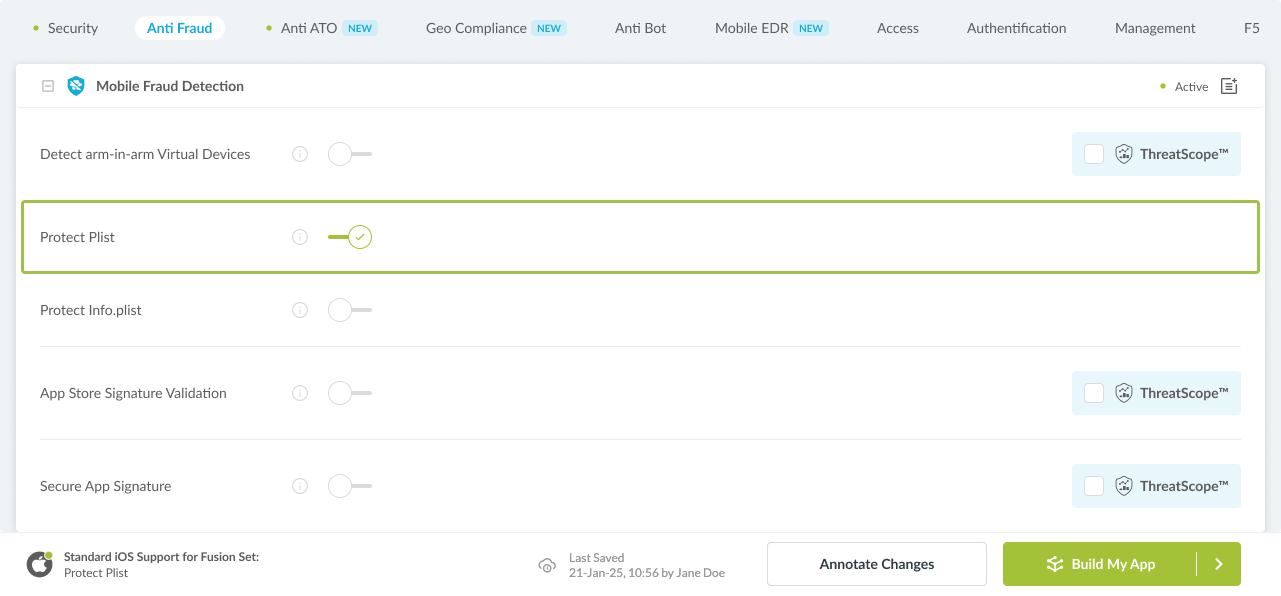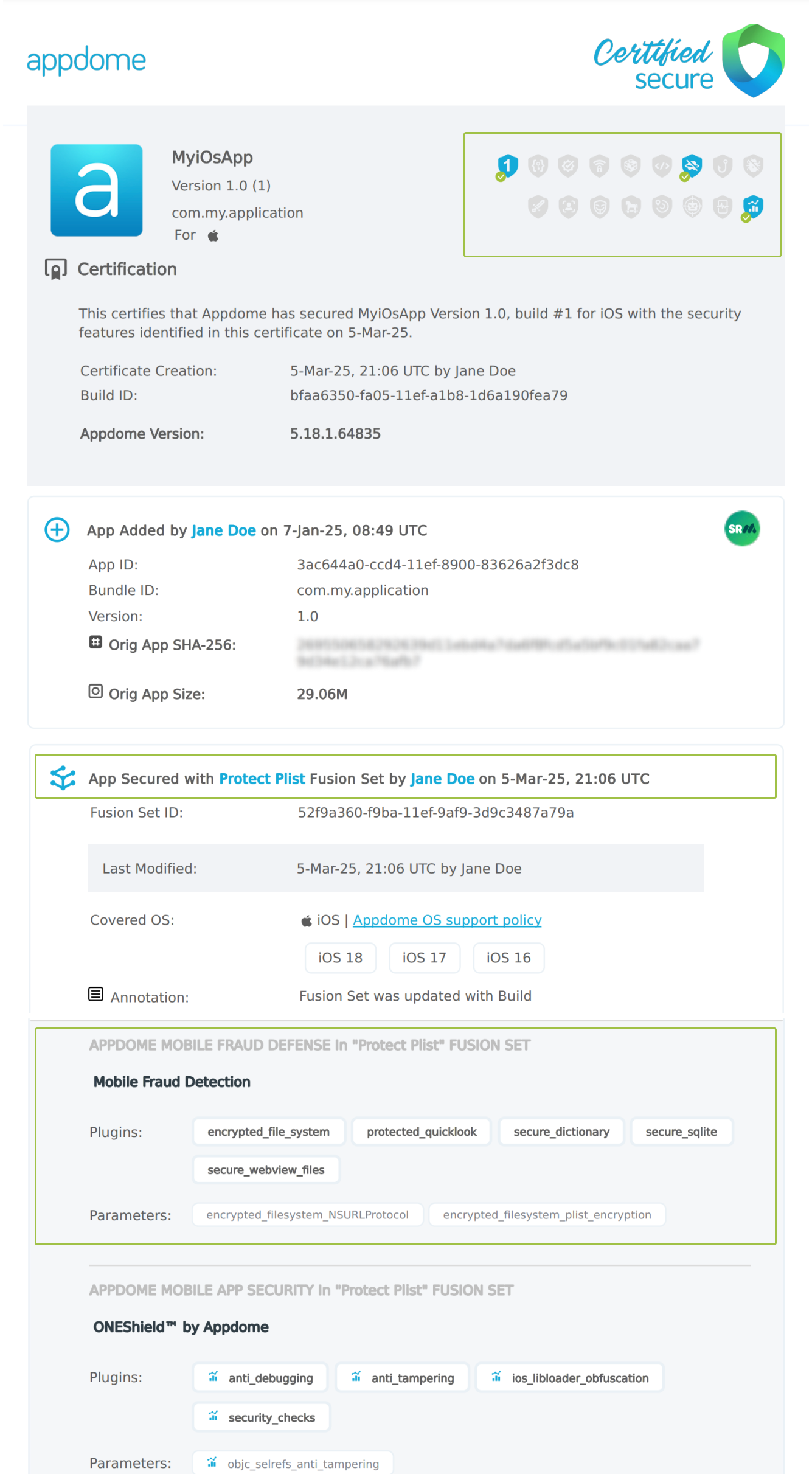How to Protect Plists (property lists) in iOS apps Using AI
This Knowledge Base article describes how to use Appdome’s AI/ML in your CI/CD pipeline to continuously deliver plugins that Prevent Plist modification in iOS apps.
What Are Plists?
In iOS apps, property lists (plists) store metadata and configurations essential to app functionality, containing key-value pairs for settings, permissions, and system interactions. Attackers often target these files to manipulate app behavior, such as altering in-game currency, disabling ads, or modifying permissions to access sensitive features like the camera or location. Without adequate protection, plist files are vulnerable to tampering, allowing attackers to bypass app controls and exploit app features. Encrypting or securing plist files prevents unauthorized access, maintaining app integrity and protecting user data against manipulation, a critical compliance measure in protecting sensitive app configurations from tampering.
How Appdome Protects Plists?
Appdome’s dynamic Protect Plist plugin encrypts all plist files in iOS apps, except for files that are required for the app to function properly (e.g., entitlements and provisioning profiles). This encryption prevents malicious users from accessing or modifying sensitive app configurations stored in the plist files, thus safeguarding the app from tampering. Whether it’s altering in-game properties or attempting to manipulate app permissions, Appdome ensures the integrity of plist files, making it difficult for attackers to exploit plist vulnerabilities. This protection is applied automatically, without the need for any coding or developer intervention.
Prerequisites for Using Appdome's Protect Plist Plugins:
To use Appdome’s mobile app security build system to Prevent Plist modification , you’ll need:
- Appdome account (create a free Appdome account here)
- A license for Protect Plist
- Mobile App (.ipa for iOS)
- Signing Credentials (see Signing Secure Android apps and Signing Secure iOS apps)
How to Implement Prevent Plist modification in iOS Apps Using Appdome
On Appdome, follow these 3 simple steps to create self-defending iOS Apps that Prevent Plist modification without an SDK or gateway:
-
Designate the Mobile App to be protected.
-
Upload an app via the Appdome Mobile Defense platform GUI or via Appdome’s DEV-API or CI/CD Plugins.
-
iOS Formats: .ipa
-
Protect Plist is compatible with: Obj-C, Java, Swift, Flutter, React Native, Unity, Xamarin, Cordova and other iOS apps.
-
-
Select the defense: Protect Plist.
-
-
Follow the steps in Sections 2.2-2.2.2 of this article to add the Protect Plist feature to your Fusion Set via the Appdome Console.
-
When you select the Protect Plist you'll notice that the Fusion Set you created in step 2.1 now bears the icon of the protection category that contains Protect Plist.

Figure 2: Fusion Set that displays the newly added Protect Plist protection
Note: Annotating the Fusion Set to identify the protection(s) selected is optional only (not mandatory). -
Open the Fusion Set Detail Summary by clicking the “...” symbol on the far-right corner of the Fusion Set. Copy the Fusion Set ID from the Fusion Set Detail Summary (as shown below):

Figure 3: Fusion Set Detail Summary
-
Follow the instructions below to use the Fusion Set ID inside any standard mobile DevOps or CI/CD toolkit like Bitrise, Jenkins, Travis, Team City, Circle CI or other system:
-
Refer to the Appdome API Reference Guide for API building instructions.
-
Look for sample APIs in Appdome’s GitHub Repository.
-
Create and name the Fusion Set (security template) that will contain the Protect Plist feature as shown below:
Figure 1: Fusion Set that will contain the Protect Plist feature
-
-
Add the Protect Plist feature to your security template.
-
Navigate to Build > Anti Fraud tab > Mobile Fraud Detection section in the Appdome Console.
-
Toggle On Protect Plist.

Figure 4: Selecting Prevent Plist modification
Note: The Appdome Platform displays the Mobile Operation Systems supported by each defense in real-time. For more details, see our OS Support Policy KB. -
Configure the User Experience Options for Protect Plist:
With Threat-Events™ OFF, Appdome provides several user experience options for mobile brands and developers.- App Compromise Notification: Customize the pop-up or toast Appdome uses to notify the user when a threat is present while using the protected mobile app.
- Short message Option. This is available for mobile devices that allow a banner notification for security events.
-
Localized Message Option. Allows Appdome users to support global languages in security notifications.

Figure 5: Default User Experience Options for Appdome’s Plist modification
-
Protect Plist Threat Code™. Appdome uses AI/ML to generate a unique code each time Protect Plist is triggered by an active threat on the mobile device. Use the code in Appdome Threat Resolution Center™ to help end users identify, find and resolve active threats on the personal mobile devices.
-
Congratulations! The Protect Plist protection is now added to the mobile app -
-
Certify the Protect Plist feature in iOS Apps
After building Protect Plist, Appdome generates a Certified Secure™ certificate to guarantee that the Protect Plist protection has been added and is protecting the app. To verify that the Protect Plist protection has been added to the mobile app, locate the protection in the Certified Secure™ certificate as shown below:

Figure 6: Certified Secure™ certificate
Each Certified Secure™ certificate provides DevOps and DevSecOps organizations the entire workflow summary, audit trail of each build, and proof of protection that Protect Plist has been added to each iOS app. Certified Secure provides instant and in-line DevSecOps compliance certification that Protect Plist and other mobile app security features are in each build of the mobile app.
Using Appdome, there are no development or coding prerequisites to build secured iOS Apps by using Protect Plist. There is no SDK and no library to code or implement in the app and no gateway to deploy in your network. All protections are built into each app and the resulting app is self-defending and self-protecting.
Releasing and Publishing Mobile Apps with Protect Plist
After successfully securing your app by using Appdome, there are several available options to complete your project, depending on your app lifecycle or workflow. These include:
- Customizing, Configuring & Branding Secure Mobile Apps.
- Deploying/Publishing Secure mobile apps to Public or Private app stores.
- Releasing Secured Android & iOS Apps built on Appdome.
Related Articles:
- How to Prevent App Signing by Unauthorized Developers
- How to Prevent non-approved Android, iOS app store publishing
- How to Block Frida Toolkits
- Block Magisk Manager and Magisk Hide
Check out Appdome’s Mobile Fraud Detection or request a demo at any time.
How Do I Learn More?
If you have any questions, please send them our way at support.appdome.com or via the chat window on the Appdome platform.
Thank you!
Thanks for visiting Appdome! Our mission is to secure every app on the planet by making mobile app security easy. We hope we’re living up to the mission with your project.
